What Is Glaucoma?
Glaucoma is an eye disease that damages your optic nerve. Glaucoma most often occurs when fluid builds up in the front part of your eye. That extra fluid increases the pressure inside your eye, which damages the optic nerve. It causes no pain and can affect one or both eyes.
Can it be treated?
There is no cure for glaucoma, but most cases can be treated in the early stages. That is why it is so important to get regular, dilated eye exams to check your eye pressure. Without treatment, glaucoma leads to permanent blindness.
Who gets it?
Anyone can develop glaucoma, but some groups are more likely to develop it, including:
- African Americans, Hispanics and Asians over age 40
- Anyone 60 and older
- Those with a family history of glaucoma
- Those with high eye pressure
- People who are far-sighted or near-sighted
- Had a previous eye injury
- Use long-term steroid medications
- Have thin corneas
- Have a thinning optic nerve
- Also, people with health problems that affect the whole body, such as diabetes, migraines, high blood pressure or poor circulation face a greater chance of developing glaucoma.1,2
Are there different types?
There are two major types of glaucoma, primary open-angle glaucoma and closed-angle glaucoma.1
Open-angle glaucoma
Open-angle glaucoma has no obvious symptoms and vision remains normal in the early stages. As the condition progresses, blind spots develop in the side (peripheral) vision. Once symptoms appear, the damage can be quite severe. This is the most common type of glaucoma.
Closed-angle glaucoma
Closed-angle glaucoma is less common and tends to develop more quickly. It is also called angle-closure glaucoma or narrow-angle glaucoma. It is generally caused by a sudden increase in eye pressure due to fluid build-up. This is a medical emergency that requires immediate surgery. Symptoms tend to come on quickly and include:
- Severe pain in the eyes or forehead
- Redness in the eye or eyes
- Decreased vision, blurred vision or seeing rainbows or halos
- Headache
- Nausea
- Vomiting
Other types of glaucoma
Other types of glaucoma include:
Normal-tension or low-tension glaucoma
People with this form of glaucoma have normal or low pressure in their eye, but still have blind spots or optic nerve damage. Treatment options are the same as for open-angle glaucoma.
Congenital glaucoma
This serious hereditary condition usually becomes noticeable soon after birth and requires prompt surgery to preserve vision.
Secondary glaucoma
Sometimes a serious medical condition will cause glaucoma as a side effect. This is known as secondary glaucoma.
For example, neovascular glaucoma may result from poorly controlled diabetes or high blood pressure. Secondary glaucoma can also arise from eye injuries or surgery for other eye conditions, such as cataracts or eye tumors.
Pigmentary glaucoma
A form of the disease that occurs when pigment from the iris sheds and blocks or slows fluid drainage.
Pseudoexfoliation glaucoma
This type of glaucoma appears when internal eye structures shed extra cells that block and then slow the draining of fluid.
How is glaucoma treated?
Glaucoma treatments include eye drops pills, surgery, or a combination of these. These treatments help save remaining vision, but do not restore sight already lost.1,2
Treating glaucoma with medication
Medicated eye drops and pills are the most common treatments used to treat glaucoma. Depending on your symptoms, your doctor may prescribe eye drops to lower eye pressure and pills to reduce fluid build-up in the eye. Regular use is important to maintain a consistently lower eye pressure and prevent the disease from getting worse.
These medications sometimes interact with other drugs, so it’s important to tell your doctor about all of the medications you are taking. Many drugs are available for glaucoma, so if you have side effects such as headaches, stinging, burning, or redness in the eyes, let your doctor know so they can prescribe a different medication.
Laser surgery for glaucoma
Laser trabeculoplasty is a type of laser surgery performed in your ophthalmologist’s office. This surgery helps drain fluid from the eye.
If you have glaucoma in both eyes, your doctor usually will conduct the procedure in one eye at a time during separate visits at least several days apart. You will probably need to keep using eye drops or taking medicine after the surgery.
Trabulectomy surgery for glaucoma
There are surgeries to treat glaucoma that must be performed in a hospital operating room. Trabeculectomy removes a small piece of tissue, creating a new channel for fluid to drain from the eye. It is performed in one eye at a time, usually several weeks apart.
You will be given different eye drops following this surgery to prevent infection and inflammation. This procedure works less well in people who have had previous eye surgery, such as cataract removal.
In another hospital surgery, the surgeon inserts a glaucoma drainage device, sort of a tiny tube, to drain extra fluid and lower eye pressure.

Join the conversation